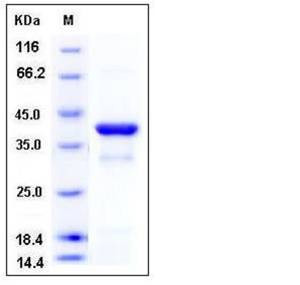Human IKB alpha / NFKBIA Protein (His Tag)
IKBA,MAD-3,NFKBI
- 100ug (NPP3991) Please inquiry
| Catalog Number | P12045-H07E |
|---|---|
| Organism Species | Human |
| Host | E. coli |
| Synonyms | IKBA,MAD-3,NFKBI |
| Molecular Weight | The recombinant human NFKBIA consisting of 323 amino acids and has a calculated molecular mass of 36.4 kDa. It migrates as an approximately 38 kDa band in SDS-PAGE under reducing conditions. |
| predicted N | Met |
| SDS-PAGE |  |
| Purity | > 90 % as determined by SDS-PAGE |
| Protein Construction | A DNA sequence encoding the human NFKBIA (NP_065390.1) (Phe 2-Leu 317) was expressed, with a polyhistide tag at the N-terminus. |
| Bio-activity | |
| Research Area | Developmental Biology |Transcription Factor & Regulator |Transcription Factor Regulator |
| Formulation | Lyophilized from sterile 50mM Tris, 0.5M NaCl, pH 8.0 1. Normally 5 % - 8 % trehalose, mannitol and 0.01% Tween80 are added as protectants before lyophilization. Specific concentrations are included in the hardcopy of COA. |
| Background | Nuclear factor of kappa light polypeptide gene enhancer in B-cells inhibitor, alpha (IkB alpha, NFKBIA, or IKBA), is a member of the NF-kappa-B inhibitor family that function to inhibit the NF-kB transcription factor. NFKBIA inhibits NF-kB by masking the nuclear localization signals (NLS) of NF-kB proteins and keeping them sequestered in an inactive state in the cytoplasm. In addition, NFKBIA blocks the ability of NF-κB transcription factors to bind to DNA, which is required for NF-kB's proper functioning. Signal-induced degradation of I kappa B alpha exposes the nuclear localization signal of NF-kappa B, thus allowing it to translocate into the nucleus and activate transcription from responsive genes. An autoregulatory loop is established when NF-kappa B induces expression of the I kappa B alpha gene and newly synthesized I kappa B alpha accumulates in the nucleus where it negatively regulates NF-kappa B-dependent transcription. As part of this post-induction repression, the nuclear export signal on I kappa B alpha mediates transport of NF-kappa B-I kappa B alpha complexes from the nucleus to the cytoplasm. Deletion of NFKBIA has an effect that is similar to the effect of EGFR amplification in the pathogenesis of glioblastoma and is associated with comparatively short survival. Polymorphisms in NFKBIA may be important in pre-disposition to and outcome after treatment, of multiple myeloma (MM). The NFKBIA gene product, IkappaBalpha, binds to NF-kappaB preventing its activation and is important in mediating resistance to apoptosis in B-cell lymphoproliferative diseases. |
| Reference |
